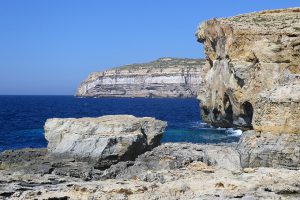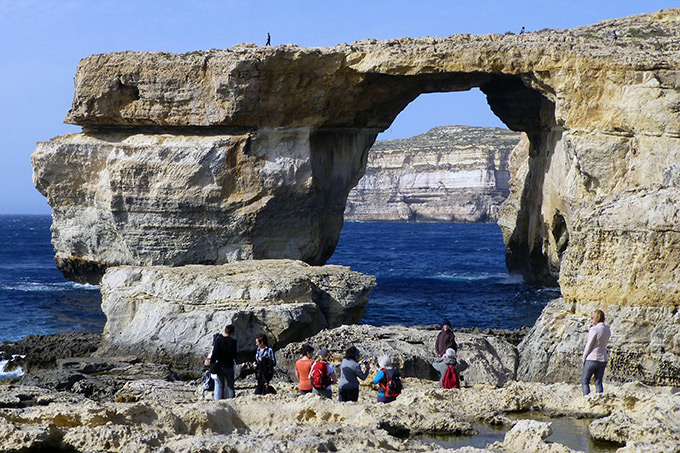Dr Alexander Kent reflects on the recent collapse of Gozo’s iconic landmark and what this means for the island today.
From Clash of the Titans (1981) to Game of Thrones (2011–), the Azure Window, a 50-metre-high honey-coloured limestone arch on the western coast of the Mediterranean island of Gozo, has been an iconic landmark on and off the screen, drawing thousands of visitors per year.
But in the early hours of 8th March 2017, heavy storms battered the Maltese Islands and washed the Azure Window clean away. Today, there is nothing left – not even a stack – for would-be admirers of the natural wonder to relish.

A geological investigation published in 2013 highlighted the fragility of the arch and suggested that it may collapse within a decade, but not imminently. Last year, in an effort to conserve the landmark, the Maltese government introduced a hefty €1,500 fine for anyone caught walking over the arch, yet many were undeterred. Any would-be violators evaded the Azure Window’s inevitable but sudden collapse; a stark warning that nature’s forces are as powerful as they are unpredictable.
The destruction of the world-famous landmark – probably the most photographed natural feature of the Maltese Islands – quickly drew international attention. The Maltese Prime Minister, Joseph Muscat, tweeted the news, calling it “Heartbreaking”, while Gozo Minister, Anton Refalo, said it was like “Losing a part of yourself“. The Azure Window was not just a popular photo spot for tourists, it was an organ of the islands’ national consciousness.
But there are very real fears that the loss of the iconic arch on this bijou Mediterranean island of 37,000 people will have a negative impact on its economy, with tourism contributing half of Gozo’s GDP (Gross Domestic Product). The Azure Window features prominently in tourist brochures and maps and in the marketing of the Maltese Islands in general. All that will now have to change.
Yet, when I took a group of Geography students to Gozo for a field exercise a few days ago, the scene was far from deserted. People are just as keen, at least for now, to see how the event has dramatically altered the view. Few other sites can match Dwejra, which includes the Inland Sea (a lagoon linked to the sea by a natural arch) and Fungus Rock (a 60-metre-high islet), for demonstrating the dynamic power of nature to create and destroy beautiful landscapes. Change is a constant feature of the coastal environment, and, for the Azure Window, its life cycle is complete.
There are other spectacular arches along the Gozitan coast (just around the corner is the Wied il-Mielaħ Window), and, as locals were keen to tell me, also some ‘secret’ ones. The sea may have taken Gozo’s most famous arch, but it has not eroded the island’s charm.
Dr Alexander Kent is Reader in Cartography and Geographic Information Science in the School of Human and Life Sciences. He has just returned from a Geography undergraduate fieldtrip to the Maltese Islands, which he led with colleagues Dr Chris Young and Dr Daniel Donoghue.
 Expert comment
Expert comment Jeanette Earl
Jeanette Earl 2037
2037


